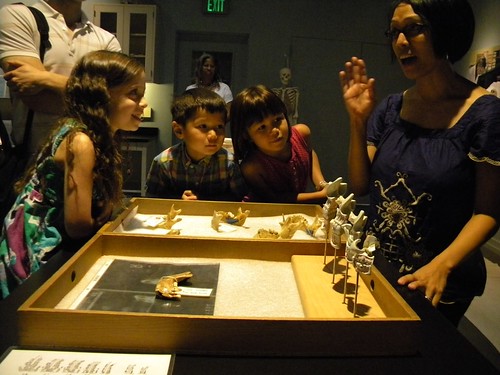The 45 Best Forensic Tech Blogs
Forensic technology encompasses a wide range of fields and technologies and is often used, with some controversy, in criminal trials. The blogs below examine forensic tech from all angles, from professionals active in the field, to journalists covering the impact and evolution of forensic technology, to skeptics concerned about the ramifications of junk science being labeled as forensic science being used to convict in trials.
Table of Contents
Forensic Science

West Midlands Police Forensic Science Lab – Photo by West Midlands Police
- Anti-Polygraph Blog – Opened: April 2006 with regular updates in the last few years. Style and Focus: Detailed and supported articles about the ways in which polygraph tests are used and abused, information about the deficiencies of the technology, and news. Also very active on Twitter. What to Read: Polygraph Countermeasures: What Polygraph Operators Say Behind Closed Doors, for a glimpse at the concerns even polygraph operators have with the reliability of the technology.
- Zeno’s Month – Opened: July 2004, with biweekly or monthly posts since then. Style and Focus: Much more of a personal blog than an informative one, this blog, run by a forensic scientist, touches a bit on his work and life. Expect vacation adventures to be mixed in with news and conference details related to the forensics industry. What to Read: October 2012: Some Challenges in Digital Evidence, for a glimpse at what forensic science was concerned with and preparing for in late 2012.
- FSN: Forensic Science News – Opened: April 2008 with post frequency varying but highly active since then. Style and Focus: This frequently updated blog provides opinionated responses to news and events related to forensics from the point of view of a professional forensic scientist. Well written and timely responses to criminal cases and forensic news and advances. What to Read: Institutional Bias Examined, for a great introduction to how insidious institutional bias can be and some thoughts on how it plays out.
- All About Forensic Science – Opened: May 2012 with fairly regular posts each month. Style and Focus: Despite the busy look of this site, it contains a wealth of information for individuals looking at entering the field of forensics. Regular posts focus on information relevant to potential forensic students or those with a casual interest. Posts are short and sweet but informative. What to Read: Mathieu Orfila, for a wonderful brief bio on one of the forefathers of forensic medicine.
- UF Forensic Science Blog – Opened: March 2012, fairly consistent with bimonthly posts. Style and Focus: This blog provides its readers with reasonably fascinating posts covering different types of forensic science along with forensic analysis in the news. Not the most frequently updated and the author is not a native English speaker (and it shows in the writing), but it is worth a gander. What to Read: Untying the Knots, for a quick and dirty overview of the importance of forensic knot analysis and the rarity of such expects (with a link for more information).
- Forensic Odontology: Bitemark Evidence – Opened: January 2011 with regular updates about once a week since. Style and Focus: With a minimalist look and easy to navigate interface, this blog welcomes readers to explore the world of bite mark evidence, with a focus on educating readers to the potential negative legal ramifications of relying on it as evidence. The author is a highly experienced professional forensic odontologist, with plenty of background to provide invaluable expertise to the posts. What to Read: Ted Bundy Bitemarks and Richard Milone: How DNA, bitemark research and failed cases have changed bitemark analysis, for an examination of how these high profile cases used bitemark evidence questionably and how it is used today.
- Forensic DNA Testing Blog – Opened: December 2007 with irregular posts since then. Style and Focus: This blog allows posts from both DNA Diagnostic Center staff and clients that concern forensic DNA testing. While DDC moderates the posts, the authors can vary and thus the style of writing as well. The blog is easy to navigate and contains a wealth of information for readers interested in keeping up news, advancements, and case studies involving forensic DNA. What to Read: New DNA Test Predicts Eye Color, for a quick article introducing a new advancement in forensic DNA analysis – the ability to predict eye color from samples left at crime scenes. Not strong enough as a sole source of information, but an asset to an investigative team.
- Forensic Astrology – Opened: July 2007 with irregular posts that appear at least once a month since. Style and Focus: Admittedly, this site is a bit of an outlier amidst genuine scientific research blogs and companies and the site reinforces this general feel with its dark background and starry banner, but the information presented makes for an interesting read. The author has a 30 year background in utilizing astrology to analyze case files with an eye for forensics and provides detailed case file information, often sent in by readers, as well as the process by which astrology is used to hunt for new details in the case. Even if you do not buy into the premise of astrology, the blog is worth a look. What to Read: Shemika Cosey – Young Lady Leaves Her Aunts Home and Disappears, for a typical case study that details the process of forensic astrology and paints a narrative of what might have happened in this disappearance.
- GunSim Ballistics Blog– Opened: March of 2009 with irregular but generally biweekly posts since then. It has slowed a bit recently. Style and Focus: No-nonsense style reminiscent of the early days of the internet, this blog’s pared down appearance suits the straight forward information it provides to readers. It focuses specifically on technology and software used in ballistics testing with helpful tips on getting the most out of it, news, and more. What to Read: Zero in the warm, shoot in the cold, for a quick look at how ballistics information can help improve cold weather sharpshooting.
- Empirical Legal Studies – Opened: February 2006 with regular and frequent posts ever since. Style and Focus: Another early internet era styled site, this collaborative effort was founded by a group of professors from a few different Law Schools with the intent to bring together empirical methodologies and legal theory. Posts can greatly vary in length, but are usually well-written and informative. They bring commentary to news, changes in legal policy, useful resources, and more. What to Read: Kahan on National Research Council critique of multivariate regression, for review of one professor’s concerns about the potential problems in research and how they influence policy view.
Forensic Medicine

Medical evidence collection – Photo by Army Medicine
- Forensic Science for Nurses – Opened: February 2011 with consistent weekly posts. Style and Focus: RN Patricia Bemis provides her readers with straightforward, to the point blog posts that give other nurses tips on how to preserve potential evidence, information on forensic nursing, and news related to the field. She also discusses the importance of keeping forensics in mind as a nurse of any stripe. What to Read: Evidence Collection in the ED, for a quick review of simple steps ED nurses can take to preserve potential evidence.
- Digital Pathology Blog – Opened: Active since 2007. Style and Focus: More like an information hub than a typical blog, this site features regular posts from experts in digital pathology on news, advancements, cast studies, and educational information. The site is a bit busy, but easy to navigate and features a lot of resources for those with an interest in the field. What to Read: The Anxiety of the Biopsy from NY Times Health Blog, for Dr. Kaplan’s response to a NY Times article on the mental health effects biopsies can have on patients.
- Forensic Medicine with Dr. Cox – Opened: Started September of 2009 with semi-sporadic posts, generally once a month. Style and Focus: While sporadically updated, this blog is nevertheless a wonderful resource for those with an interest in forensics, particularly with a medical bent. Written by professional forensic pathologist and neuropathologist, Dr. Cox, each post is designed to inform and instruct readers on an aspect of forensics. Often, the blog posts are short introductions to longer papers linked in the post. What to Read: Human Skeletal Remains – An Introduction to Forensic Anthropology, for an introduction to a well-written and informative article introducing readers to the important concepts in forensic anthropology.
Forensic Museums and Historians

Forensic Anthropology Lab – National Museum of Natural History – Photo by Leticia (Tech Savvy Mama)
- Crime Museum’s Criminal Convictions Blog – Opened: February 2009 with consistent weekly posts since. Style and Focus: This blog is run by a museum and readers can expect highly entertaining, detailed, and well-written posts covering crime, criminals, and forensics. Recently, they posted the story of a potential real-life inspiration for the American mythical hero the Lone Ranger. The site itself is well designed and easy to navigate and offers readers more than just a lively and engaging blog. What to Read: The Vidocq Society: ‘The Heirs of Sherlock Holmes’? A glimpse into first real life French undercover detective agency and the fascinating character who helped found it, former criminal reformed into detective, Eugene Vidocq.
- The Writer’s Forensics Blog– Opened: May 2009 with regular posts since. Style and Focus: This blog’s intended audience is writers who want realistic, informative advice and information on forensics. It includes general writing advice, like how to make your first few pages shine, and detailed information on a whole range of forensic science. A fascinating read if you have an interest in forensics at all. The design is clean and easy to navigate, with lots of resources and great organizational tools. What to Read: Connecticut Massacre Not New, Just Disturbing, for a quick and dirty guide to the assorted classifications of multiple murderers and real-life examples of such.
- Jen J. Danna ~ Forensic Crime Writer – Opened: April 2011 with regular posts since, generally updated Tuesday evenings. Style and Focus: Another writer’s blog, this one expands beyond simply advice for authors, it chronicles this author’s journey in writing, provides information on research, writing processes, and the path to publication. She also does an excellent job in covering forensic science and how it can be effectively used in writing. She has a particular focus on forensic anthropology. What to Read: Forensic Case Files: Cannibalism in Jamestown in the Early 17th Century, for a gruesome look, figuratively and literally, at some of the evidence illuminating the meal-times at Jamestown colony, courtesy one 14 year old immigrant.
Computer Forensics

Photo by West Midlands Police
- Computer Forensics Blog – Opened: August 2008 with very frequent posts ever since, generally more than twice a week. Style and Focus: This highly active blog is a fantastic resource for any computer forensics professional or individual interested. They keep readers informed of product information, news, and events while also providing lots of tips and guides to improve one’s computer forensic tool bag. What to Read: Four Focus Areas of Malware Analysis, for an informative post briefly explaining one method of analyzing malware.
- Digital Forensics Blog – Opened: November 2010 with sporadic updates, generally once a month. Style and Focus: While this blog isn’t frequently updated, it does provide excellent information and tips targeting other computer forensic personnel. The author provides advice born from practice, events relevant to the field, news, advancements, and more. What to Read: No Partition Table? No Problem, for a helpful post targeting newer computer forensic professionals who need a way around disks lacking partitions they need to mount.
- Random Thoughts of Forensics – Opened: February 2010 with posts generally updated once a month. Style and Focus: More of a personal blog than one designed to provide a great deal of professional advice and resources, it provides a glimpse into the journey of one student of computer forensics and includes his experiences with different forensics techniques and triumphs along with personal and professional experiences alike.What to Read: Tools in the Toolbox Mandiant Red Curtain, a quick and dirty overview of a free software for Incident Responders analyzing malware.
- Didier Stevens – Opened: June 2006 with regular posts from that point forward. Style and Focus: This is not a blog for those with a casual interest, it is full of technical details and step-by-step instructions designed to share ideas, tactics, and resources with other professionals. Regularly updated and on a wide variety of related topics, this is a highly useful tool for any computer professional interested in forensics. What to Read: Quickpost: TeamViewer and Proxies, a quick and dirty how-to post.
- Windows Incident Response Blog – Opened: December 2004 with very active and regular posts, at least one a week, frequently more. Style and Focus: This long running blog is focused on providing resources to professionals involved in computer and digital forensics with Windows systems. Most posts are focused on explaining different analysis approaches or techniques, but it also informs readers of news updates, products, and events. What to Read: There Are Four Lights: The Analysis Matrix, for an explanation of analysis matrix and how it can be used to more effectively analyze data.
- Forensic Focus Blog – Opened: November 2007, generally updates often. Style and Focus: Focused on providing news and tools for other computer forensic professionals, this blog features well written and tool-packed articles, interviews with folks in the industry, news, reviews, and more. The site itself is slightly busy, but well organized and easy to navigate. What to Read: Generating computer forensic supertimelines under Linux: A comprehensive guide for Windows-based disk images, for a guide to the assorted solutions available to assist with creating digital forensic timelines with code files.
- Forensic 4:cast – Opened: January 2008 with regular and fairly consistent weekly updates. Style and Focus: This sleek and well-designed site offers its visitors a wealth of information related to digital forensics delivered in podcast format with discussions from a range of industry experts. They also run a regular newsletter that supplements the information provided in the podcasts. They also host the 4:cast awards to acknowledge great forensic tools, resources, and individuals in the field. What to Read: How to do the worst job possible, presenting a very poorly written forensic report.
- Mobile & Technology eDiscovery – Opened: November 2006, with somewhat sporadic posts, but generally at least one a week since open. Style and Focus: While it doesn’t present the most elegant design ever, the blog delivers excellent content for readers involved or interested in digital forensics. It features regular articles on tools, best practices, resources, case studies, and more. What to Read: Signal Strength and Distance, for a discussion on what cellular signal strength and distance is and how to discuss it in court.
- CSItech– Opened: May of 2008, with bimonthly posts since. Style and Focus: The clean layout allows readers to focus on the content, which is focused on informing readers about newly developed tools and tactics designed to improve the computer forensics industry. Expect lots of reviews and guides on using new tech and practices. What to Read: Password extraction fun, for a good review of a program that can help uncover passwords on devices first responders need to access quickly.
Forensic Technology & Techniques

Fingerprint – Image by CPOA
- Crime Scene Training – Opened: December 2010 with fairly consistent, frequent posts. Style and Focus: This very well organized blog has been regularly providing advice, insight, product reviews, and more targeting any investigators who do any part of their work directly at the crime scene. Articles are informative and practically useful. What to Read: Avoiding Hazards at the Crime Scene, for a well-written, thorough, and extremely handy article for any forensic tech who goes on scene.
- The Truth about Forensic Science – Opened: February 2010, with frequent and regular updates. Style and Focus: This blog targets DUI lawyers and criminal defense attorneys and helps educate its readers on the different types of forensic evidence that can be brought to a trial, with a focus on weaknesses and defenses against them. The blog is authored by a highly respected criminal defense and DUI attorney. What to Read: Limitations of Forensic Odontology, for an overview of the problems with forensic odontology.
- The Hacker Factor Blog – Opened: November of 2006, with fairly regular posts at least once a month since then. In the last two years, it has trended towards weekly updates. Style and Focus: This blog is a treasure, with entertaining and informative posts that are often designed to generate discussion amidst the readers. The primary focus is on the tools and techniques designed to help computer techs of all sorts, but it occasionally drifts into completely unrelated but often fascinating territory. What to Read: Chasing Rainbows, for a really fascinating article discussing super-senses.
- Forensic Methods – Opened: August 2009 with sporadic but fairly regular posts since then. Style and Focus: The layout of this blog makes it feel more like a digital magazine than a traditional blog, and its posts take a non-traditional spin too. Some are simply quick Twitter updates; others are snippets of a great article found elsewhere with a shortened link to the primary article. Still, the original content here is not to be missed; the articles are well-written and informative and often offer a behind the scenes glance at the writing process. What to Read: Digital Forensics Magazine: Big Brother Forensics, for an article on an article, also a brief introduction to the potential ramifications of geo-location technologies.
- Forensic Resources – Opened: July 2011 with frequent posts, often more than once a week, since then. Style and Focus: A sleek and well-written blog providing detailed information about forensic science, including techniques, news, legal issues, and advancements. It caters primarily to attorneys based in North Carolina, but is a worthy read for anyone who needs to increase their armchair knowledge of the science. What to Read: Improving Arson Investigations, a resource-filled article pointing readers towards new developments in science that shook up fire investigation.
Cold Cases & Wrongful Convictions
- Defrosting Cold Cases– Opened: November of 2009 with prolific posting habits, though slightly slower in recent months. Style and Focus: The blogger clearly cares about justice for victims who have been left behind by time. Posts are frequently focused on bringing light to cold cases that may have been gathering dust, telling the stories of the victims, and sharing information about the crimes. The author also focuses on wrongful convictions and forensic information that may help solve some of these cases. The site is beautifully designed, easy to navigate, and the articles are well-written. What to Read: In Loving Memory: Jimmy Stanaway, for a heartfelt memorial to a cold-case victim, providing a personal face to a dusty file.
- The Wrongful Convictions Blog – Opened: It’s hard to pinpoint the open date of this blog, but it is currently highly prolific, with often multiple posts in a day. Style and Focus: Informative, well-written, and prolific, this blog features a panel of expert authors from a variety of backgrounds to bring readers the latest in news about wrongful convictions, including forensic analysis changes, case studies, legal changes, and more. The site is a little difficult to navigate, as it lacks a proper archive; users can search, or sort through categories to find what they are after. What to Read: Calculating Bad Math’s Contribution to Wrongful Convictions, for an interesting analysis of how a judge or jury’s failure to comprehend mathematics might lead to miscarriages of justice.
Fraud & Crime Blogs

Fraud Tech on a $20 – Image by Jack Spades
- The Fraud Files Blog– Opened: November 2005, with prolific and regular posts since. Style and Focus: This blog is focused on fraud of all kinds, from small to massive, on a national scale. Expect lots of links to related information, quality writing, and informative posts. What to Read: MckMama House Fire is Not Suspicious In the Least.
- Expert Witness Blog – Opened: March of 2007, with near daily posts. Style and Focus: Most posts are very brief and present readers with information about what expert witnesses are testifying about in trials around the nation. Some posts focus on preparing witnesses for trial, news, or other relevant information. What to Read: Environmental Health Expert Witnesses & Hanford Nuclear Reservation, for a typical post example.
- Grits for Breakfast – Opened: January 2004, with highly prolific and regular posts since then. Style and Focus: A very well-respected blog focused on Texas criminal justice. The author has been recognized for his excellence from a number of Texas newspapers, organizations, and other criminal justice bloggers and even won a handful of awards over the years. Except quality writing, well-researched content, and no-nonsense (and often contrary) opinion delivered near daily. What to Read: A forensic science ‘blockbuster’ and limits of accreditation, taking a glance at several forensic science news articles and points to the shaky ground some forensic data is built upon.
Forensic Anthropology & Psychology

Bones in the Monasterio de San Francisco, Lime, Peru. Photo by Phil Whitehouse.
- Forensic Psychologist – Opened: April of 2007, with at least a post a week consistently since then. Style and Focus: The site itself is a little aged, but that has no impact on the quality of its contents. Blogger Karen Franklin, Ph.D. is an experienced forensic psychologist and adjunct professor who has served as a criminal investigator and legal journalist. She has the chops and the ability to write effectively about what she knows. Her posts cover news, resources, case studies, methodologies, and more in the fields of criminology, forensic psychology, and psychology law. What to Read: Beware “voodoo” brain science, for an examination of some of the controversial claims made by proponents of brain imaging as a way to distinguish potentially dangerous traits in an individual.
- Mind Hacks – Opened: November 2004 with consistent and prolific posts since. Style and Focus: Clean design with easy navigation introduces readers to a site loaded with information presented from very prolific bloggers. Posts focus on the fascinating world of neuroscience and psychology. Well-written responses to news articles, explanations of weird brain quirks, neuroscience history and notable figures, and much more can be found here. What to Read: A brief history of narcoanalysis, for a fascinating introduction to the use and history of the administering of ‘truth drugs’ to elicit supposedly truthful confessions.
- Smith Forensic – Opened: September of 2004 with consistent and prolific posts since. Style and Focus: This blog offers a simple, clean style and easy navigation with a focus on forensic pathology as presented by blogger Harold Levy, a Toronto Star investigative journalist who gained an interest through his reporting on once famed doctor Charles Smith. His blog examines flawed pathology and delves into the cases they impact around the world. He also examines junk science and its impact in criminology broadly. What to Read: Marvin Wilson: How Texas is using literature rather than scientific methodology to kill a clearly retarded man – to circumvent the U.S. Supreme Court. – For a heart-rending examination of an abuse of the justice system, forensic science, and one man’s life.
- Bones Don’t Lie – Opened: Style and Focus: Written by mortuary archaeology and bioarchaeology graduate student Katy, this blog shares her discoveries, like a recent dig in Oakington containing the burials of over 100 Saxons. She also writes about forensic techniques, archeological history, news, and more on a blog that is beautiful and easy to navigate. What to Read: Displaying the Famous Political Dead, for an interesting glimpse into the practice of preserving the notable dead for public display.
Forensic Companies
- Forensic Technology Newswire – Opened: April 2009 with frequent but irregular posts. Style and Focus: Their style is much more like a newsfeed than a personal blog, they keep readers up to date on how their products are being used and received around the world, as expected from a company blog, but they do so with solid and informative writing. What to Read: CSI: Miami & Real Forensics: We Won’t Get Fooled Again, for a post examining the relationship between CSI and real life crime solving.
- Forensics Blog (BCIT)– Opened: July 2010 with consistent weekly posts since. Style and Focus: A simple interface greets visitors in this Forensic Institute’s blog focused on forensic education, Canadian forensics, news, events, and advancements in forensic science. Most posts are short and sweet. Those local to the area will also find timely related job postings and course updates. What to Read: Forensics’ Grad Bringing Backpacks to the Homeless, for a lovely quick bio on a recent BCIT graduate doing good for her community.
- The Forensic Group – Opened: Style and Focus: Clean and straightforward writing designed to inform and educate readers on the methods and developments in computer forensics tactics and technology. Some news and events are introduced as well as case studies. Clean interface but somewhat difficult to navigate. What to Read: Computer Forensic Artifacts: Windows 7 Shellbags, for an informative introduction to how Win7 Shellbags can be used to trace activity and contents in computer forensics.
Forensic Imagery & Artists

1940 Mugshot – Image by Lisa Bailey
- Four And Six – Opened: June 2011 with regular posts, about one a week, consistently since day one. Style and Focus: Four and Six offers its readers a clean style with useful posts ranging from image forensics techniques to thoughtful posts on ethical treatment of imaging tools and news and information related to image tampering. What to Read: The Case of the Pole in the Middle of the Road, for a nifty inside glimpse into what photographic forensic investigation.
- Forensic Video and Image Analysis – Opened: September 2007 with consistent and prolific posts ever since. Style and Focus: An absolutely fantastic resource for anyone who is involved or interested in image forensics, this highly active blog provides readers with information or resources on tools, software, product reviews, technique basics, image forensic cases, educational opportunities, and a mix of personal insight. Very informative, well-written, and easy to navigate. What to Read: Learn new Photoshop features in a click, for an introduction to a free and handy tool available to improve your Photoshop CS6 experience.
- Ask a Forensic Artist – Opened: January 2010 with regular and prolific posts since. Style and Focus: This well-designed blog is a great tool for other forensic artists, those who want to be, and those who are just simply fascinated by the process. It includes techniques, news, educational opportunities, fascinating interviews from other forensic artists, and more. What to Read: The “Pencil Trick” for Edentulous Skulls… Debunked, for a great breakdown of what the pencil trick is, and why it doesn’t at all work as it is supposed to, with photographic evidence.

